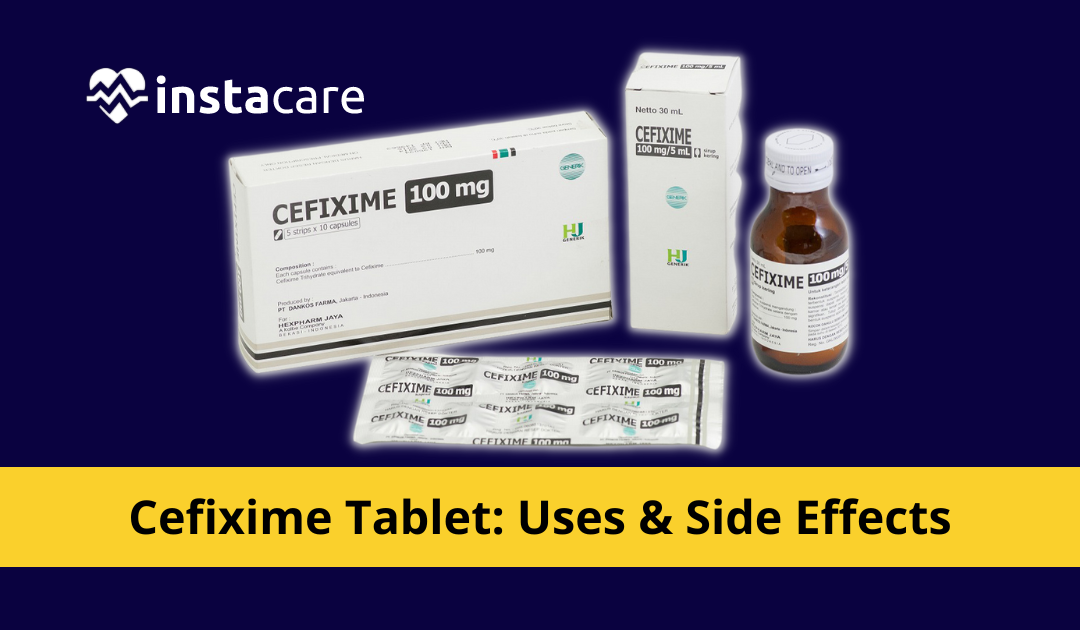In many different body areas, cefixime is also used to treat bacterial infections. It is also a member of the cephalosporin antibiotics drug class. It functions by eradicating bacteria or stopping their growth. However, this medication won't help with the flu, the common cold, or other viral infections.
Only a prescription from your doctor is required to purchase this medication. There are several dosing formulations for this product:
- Capsule
- Chewable and tablet
- For Suspension: Powder
Uses of Cefixime Tablet
Cefixime tablet uses include:
- Several different types of bacterial infections are treated with cefixime.
- An antibiotic called cephalosporin is what this drug is.
- It acts by preventing bacterial development.
- This antibiotic treats only bacterial illnesses.
- For viral infections, it is ineffective (such as the common cold and flu).
- Any overused antibiotic may stop working to treat subsequent diseases.
How is this medication to be taken?
Cefixime is available as a chewable tablet, capsule, and liquid suspension for oral administration. It is often given every 12 or 24 hours, with or without food. It can be used in a single dose while treating gonorrhoea. Cefixime should be taken every day at roughly the same time. Ask your doctor or pharmacist to explain instructions on your prescription label that you need clarification on following. Follow the cefixime directions strictly. Only take it in smaller or fewer amounts or more frequently than directed by your doctor. Before each use, thoroughly shake the suspension to combine the medication.
View More: Zeegap Tablet - Uses Side Effects and Price in Pakistan
Effects of Cefixime
If you also have any of the following symptoms of an allergic response to cefixime: hives, trouble breathing, swelling of also your face, lips, tongue, or throat, get emergency medical attention. The side effects of cefixime could be really bad. If you experience any of the following:
- Severe abdominal pain, bloody or watery diarrhoea
- Jaundice (yellowing of the skin or eyes) (yellowing of skin or eyes)
- Black urine, yellowed or pale skin, disorientation, or weakness
- A convulsion (convulsions)
- Low blood cell counts can cause sudden weakness or illness, fever, chills, flu-like symptoms, swollen gums, mouth sores, and skin sores. They can also cause pale skin, quick bruising, irregular bleeding, and dizziness.
- Renal difficulties include little to no urination, painful or difficult urination, ankle or foot edoema, and fatigue or shortness of breath.
Cefixime's typical adverse effects could include the following:
- indigestion and abdominal aches;
- vomiting and nausea
- itching or leaking from the vagina.
There may be additional adverse effects; this is not a comprehensive list. For medical advice about side effects, contact your doctor.
Dosage
The dosage of this medication will vary depending on the patient. Observe your doctor's instructions or the label's instructions. The following details only the typical dosages of this medication. Unless your doctor instructs you to keep your dose the same as the recommended one.
The strength of the medication determines how much of it you should take. Additionally, the medical condition for which you are utilizing the medication affects the number of dosages you take each day, the interval between doses, and also the duration of treatment.
For tablets, capsules, chewable tablets, suspensions, or other oral dose forms:
Against infections
- Four hundred milligrams (mg) once daily or 200 mg every 12 hours for adults and kids older than 12 and weighing more than 50 kilograms (kg).
- Children between also the ages of 6 months and 12 years—Your doctor will select the dosage for your child based on body weight. The dosage is typically divided into two doses of 4 mg/kg of body weight every 12 hours or 8 mg per kilogram daily.
- Children under six months of age: Your doctor will determine the use and dosage.
What Might Things Interact With This Drug?
This list probably covers not all combinations. List all the pharmaceuticals, herbs, over-the-counter remedies, and nutritional supplements you take for your health. Also, let them know whether you smoke, consume alcohol, or engage in illicit drug usage. Certain things may impact your medicine.
What Should I do With my Medicine?
- Keep out of children's and animals' reach.
- Store between 20 and 25 degrees Celsius at room temperature (68- and 77 degrees F).
- If a medicine has not been utilised by the expiration date, dispose of it.
Conclusion
Keep all of your appointments with your physician and the lab. Your doctor may request specific lab tests to determine how you respond to cefixime. Use Clinistix or TesTape (not Clinitest) to test also your urine for sugar if you also have diabetes and are taking this medicine. No one else should take your medication. Likely, your prescription cannot be renewed. You should also maintain a written record of every medication you take, including any over-the-counter (OTC) items, prescription drugs, and dietary supplements like vitamins and minerals. This list should be brought with you whenever you see a doctor or are admitted to the hospital. The approximate price in Pakistan of a Cefixime Tablet is Rs. 380/-
You can easily buy online medicine In Pakistan and get it delivered to your doorstep with InstaCare. Visit the website or call at 0317-1777509 for further information.
Source: https://instacare.pk/blog/cefixime-tablet-uses-side-effects-dosage-and-price-in-pakistan

